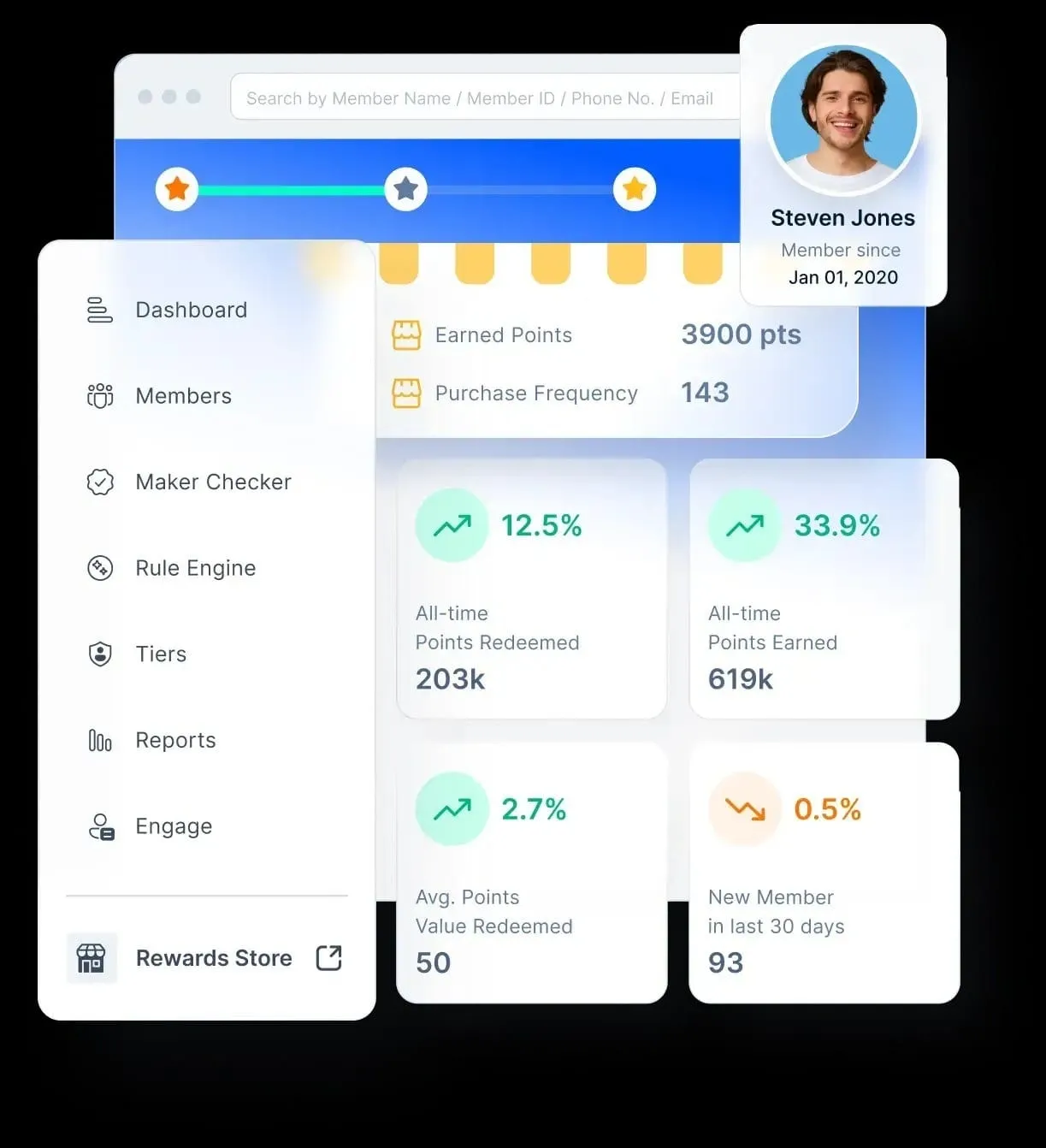How to Create an Amazing Customer Referral Program
A well-structured customer referral program can drive growth by turning happy customers into brand advocates. From selecting the right incentives to leveraging social media, this guide explores how to build an effective referral strategy that attracts new leads while rewarding loyal customers.
On this page
Word-of-mouth has always been a trusted method of driving business growth. People are more likely to trust recommendations from friends or family over traditional advertisements. A customer referral program takes this natural behavior and enhances it by offering incentives to encourage customers to share their experiences.
Studies show that 92% of consumers trust referrals from people they know, making them one of the most effective forms of marketing. Moreover, referred customers often bring greater value — research highlights that referred customers are 18% more likely to stay loyal and spend 13% more on purchases than non-referred ones.
The referral program meaning is crucial—it’s not just about customer acquisition but also about creating a deeper connection with your audience. It rewards loyal customers for their advocacy, turning them into brand ambassadors.
Businesses of all sizes, from startups to established corporations, have harnessed referral programs to achieve sustainable growth, proving their adaptability across industries.
This strategy, built on trust and mutual benefit, is not just cost-effective but also creates a community around a brand. With the right structure and incentives, a referral program can become a key driver for both customer acquisition and retention
What is a referral program and how does it work?
Referral marketing leverages word-of-mouth to turn customers into brand advocates. By offering incentives like gift cards, loyalty points, or branded merchandise, businesses encourage satisfied customers to share their positive experiences.
Through referral programs, customers can easily spread the word by sharing unique referral links or discount codes with their network, helping attract new customers while earning rewards for their advocacy.
But how does it work?
A customer referral program serves as a powerful retention strategy by integrating the right technology, products, messaging, and incentives to foster brand loyalty and advocacy.
To ensure success, businesses often leverage marketing software and lead generation tools to track referrals. When an existing customer shares a unique referral code or link and a new customer makes a purchase using it, the referrer earns a reward. This cycle continues as new customers repeat the process, creating a continuous stream of referrals and organic business growth.
By delivering value and enhancing customer experience, brands build trust and credibility. People naturally share positive experiences, especially when it benefits their network. A recommendation from a trusted source carries significant influence, making referred customers more likely to engage with and purchase from the brand.
Benefits of customer referral programs
Here are the benefits of the customer referral program:
Strengthen customer trust
With customer retention becoming increasingly competitive and online reviews losing credibility due to concerns over authenticity, personal referrals hold more weight than ever. While shoppers may be skeptical of anonymous online reviews, they are far more likely to trust recommendations from friends, family, or colleagues.
Customers acquired through referrals also tend to develop stronger brand loyalty, increasing the likelihood of repeat business.
Acquiring new customers at a lower cost
Referral marketing taps into an existing customer base to attract new users organically. Unlike traditional advertising channels, referral programs rely on satisfied customers to spread the word, reducing overall customer acquisition costs (CAC).
Beyond an initial investment in launching the program and offering incentives, referrals provide a cost-effective and sustainable way to grow your audience.
Boost revenue and customer engagement
Referral programs drive sales from both new and existing customers. By incentivizing loyal buyers to promote your brand and rewarding referred customers for making their first purchase, businesses can increase conversions and revenue without heavily relying on paid advertising.
This dual-impact approach enhances profitability while fostering long-term customer engagement.
How to build a customer referral program in 5 steps
A well-executed customer referral program can become a powerful tool to drive business growth. It involves more than offering rewards; it requires careful planning and understanding of customer behavior. Here’s a step-by-step guide to building an effective program:
1. Set clear objectives
Define what the program aims to achieve. Are you looking to acquire new customers, increase purchase frequency, or enhance customer loyalty? Having specific goals helps align the program with your business strategy. For instance, a goal to increase customer retention may require different rewards compared to acquiring new customers.
2. Leverage customer referral templates
Simplify the process of launching and managing a referral program by using pre-built customer referral templates. These templates provide clear, concise messaging for requesting referrals, following up, and thanking customers—helping businesses streamline communication and encourage participation.
3. Define key performance indicators (KPIs) and goals
Before rolling out your referral program, establish measurable goals and key performance indicators (KPIs). Clearly define what success looks like and track metrics such as:
- The number of new leads generated through referrals
- Growth in social media followers or newsletter subscribers
- Revenue increases or improvements in conversion rates
Setting benchmarks ensures you can monitor the program’s impact and optimize it for better results.
4. Select the right incentives and rewards
Understand your audience and tailor rewards to appeal to different customer preferences. While staying within budget, offer a mix of incentives to maximize engagement, such as:
- Exclusive discounts or coupons
- Store credits or loyalty points
- Free products, giveaways, or service upgrades
- Branded swag and promotional merchandise
If working with limited resources, consider leveraging surplus inventory or experience-based rewards to maintain program profitability.
5. Promote the program on the right channels
To maximize participation, ensure your referral program is visible across the channels your customers frequent. Strategies include:
- Social media: Share referral links on platforms where your audience is most active.
- Email marketing: Send targeted emails with clear calls to action for referring friends.
- Website & blog: Highlight the program with banners, pop-ups, or dedicated landing pages.
- Live chat & customer support: Encourage agents to mention the program during interactions.
- Invoices & receipts: Include referral details in transaction confirmations to keep it top of mind.
Using multiple touchpoints increases visibility and boosts engagement.
6. Continuously monitor and optimize
A referral program isn’t a one-time effort, it requires regular analysis and refinement. Use customer insights, analytics tools, and performance data to:
- Track referral success rates and conversion metrics.
- Identify and remove bottlenecks in the user journey.
- Adjust incentives and messaging based on customer behavior.
Consistently refining your program ensures it remains relevant, valuable, and effective in driving sustainable customer acquisition and retention.
Referral marketing doesn’t happen automatically—it needs promotion, especially on social media. While referrals are driven by word of mouth, in the digital age, that conversation largely happens online. Social media offers a powerful and effortless way to amplify referral campaigns.
Did you know?
➼ 95% of millennials follow brands on social media, and 28% of the demographic say they won’t try a product without their friends’ approval. (InfusionSoft, Extole)
➼ Of all the social media platforms in the U.S, the majority of referral sales during Q1 2020 happened on Facebook. It outranked other platforms with 42.6%. Interestingly, smartphones were one of the overwhelming drivers of social referrals. (eMarketer)
➼ 75% of Instagram users share information or buy a product inspired by posts that are liked or shared by their friends. (Techcrunch)
➼ 79% of the users on Facebook will like a product or brand page if they receive discounts or some kind of incentives. (MarketForce)
A referral program that works on social media means you can stop marketing on a micro-scale and leverage massive potential customers’ networks.
People are highly likely to engage and share content from social media. This increased exposure also gives an excellent opportunity for your referral programs to go viral.
Types of customer referral programs
A well-designed referral program can be a powerful tool for generating new leads, but its success depends on how it’s structured. Choosing the right referral model ensures maximum engagement and effectiveness. Below are the various types of referral programs that businesses can implement.
1. Fixed reward program
In a fixed reward model, every successful referral earns the same incentive, regardless of how many referrals a customer makes. Customers receive their reward once the person they referred completes a purchase.
For two-sided programs, both the referrer and the new customer can receive identical or distinct rewards. While this approach is easy to manage and implement, its effectiveness may decrease over time as a customer engagement plateaus.
2. Tiered reward program
A tiered system increases the reward value based on the number of referrals a customer generates. The more people they refer, the greater the incentives they unlock.
For instance, a customer might earn $10 for their first five referrals and then receive $25 for every referral beyond that. Businesses can further refine this system by offering escalating rewards for both referrers and new customers, making it a highly engaging approach.
3. Multi-step reward program
This model rewards customers at different stages of the referral journey. Instead of a single reward upon purchase, incentives are provided as the referred individual progresses through key milestones, such as:
- Step 1: The referrer earns $10 when their referral signs up for a demo.
- Step 2: Another $10 is awarded when the referral books a training session.
- Step 3: A final $25 reward is given when the referral completes a purchase.
This approach nurtures engagement throughout the customer journey, ensuring prospects stay engaged from awareness to conversion.
4.Gamified reward program
Adding gamification to referral marketing can make the process more exciting and competitive. Customers are encouraged to refer as many people as possible within a specific time frame, with top performers earning exclusive or high-value rewards.
This structure is ideal for seasonal promotions, holiday campaigns, or time-sensitive sales events. However, it requires careful planning, as tracking and rewarding top referrers must be managed effectively to maintain engagement.
5. One-sided referral programs
In a one-sided system, only one party, either the referrer or the new customer—receives a reward.
- Rewarding the referrer: Encourages loyal customers to advocate for your brand but may not entice new customers to make a purchase.
- Rewarding the referred customer: Attracts new buyers by offering an incentive upfront, but existing customers may feel less motivated to refer others.
This model works best for brands with highly engaged customers who already have a strong connection with the business.
6. Two-sided referral programs
A two-sided reward system benefits both the referrer and the referred individual. This approach creates a win-win situation and significantly boosts participation rates.
- Both parties can receive the same reward, or businesses can structure different incentives for each side.
- Since each participant gains a benefit, engagement levels tend to be higher compared to one-sided programs.
8 Customer referral program ideas to boost engagement
A well-structured referral program can significantly enhance customer acquisition while fostering brand loyalty. Whether your business offers ongoing services or one-time purchases, the right referral incentives can drive engagement.
Explore these referral strategies tailored for different industries.
1. Discounts or upgrades for recurring services
Perfect for subscription-based or repeat-service businesses such as house cleaning, lawn care, or pet grooming. Offer discounts on future services, partial refunds on past services, or free service upgrades as an incentive for every successful referral. This approach keeps current customers engaged while attracting new ones with appealing perks.
2. Gifts or cash rewards for one-time services
Ideal for businesses offering occasional or one-off services like plumbing, roofing, or auto detailing. Instead of service-based discounts, provide referrers with prepaid gift cards, branded merchandise, or cash rewards to encourage participation. This strategy ensures customers stay motivated even if they don’t need your service frequently.
3. Double-sided referral rewards
Encourage both the existing customer and the new customer to participate, creating a mutually beneficial relationship. Reward the referrer with store credit, cash bonuses, or discounts, while offering the referred customer an incentive like a welcome discount or free add-on service. This ensures higher engagement rates and a steady stream of new customers.
4. Referral contests
Create excitement by offering high-value prizes to customers who bring in the most referrals within a set period. Whether it’s a free annual service, a substantial cash prize, or an exclusive experience, contests generate buzz and encourage quick participation. Set up leaderboard-style tracking to fuel healthy competition among participants.
5. Seasonal and holiday-themed referral programs
Leverage peak seasons like back-to-school, Black Friday, or the holiday season to boost referrals with time-limited incentives. Offer festive rewards such as bonus discounts, gift cards, or holiday-themed merchandise. A sense of urgency makes customers act faster to maximize their benefits before the season ends.
6. Charitable referral incentives
For socially conscious brands, giving back can be a powerful motivator. Instead of offering cash incentives, donate to a charity of the referrer’s choice for each successful referral. Publicize the impact through updates, like "We've donated $5,000 to local food banks thanks to our customers’ referrals!" to encourage further participation.
7. Tiered rewards for high engagement
Encourage repeat referrals by increasing incentives as customers refer more people. For example, a referrer earns a small discount for their first referral, a free product for their fifth, and a VIP service upgrade after ten. This motivates long-term engagement, loyalty and gives customers an incentive to keep sharing.
8. Business partnership referral programs
Collaborate with complementary brands to extend your reach and offer more value to customers.
For example, HubSpot and LinkedIn partnered to offer marketing and sales professionals better insights by integrating LinkedIn Sales Navigator with HubSpot’s CRM. This collaboration allowed HubSpot users to seamlessly access LinkedIn insights within their workflows, making customer outreach more efficient while introducing LinkedIn users to HubSpot’s CRM capabilities.
5 Email templates to use for your referral programs
Take advantage of our high converting, fully customizable referral email templates along with useful tips and tricks.
Scenario 1: Asking a current customer if they have anyone in mind to refer to you
I hope you’re doing great!
I’m glad to hear that [service/product] has worked well for you and your team. I knew that by working together, we’d be able to drive a lot of impact for [insert their brand’s name].
Given the success you have seen, I wonder if you may know of any [colleagues/friends] who are looking to [insert core value proposition of your product/service – e.g., “improve their blog’s conversion”]. I would love to help your acquaintances achieve the same results you’ve seen.
Also, as a thank you for your consideration, a $20 Apple gift card shall come over your way post our email :)
Kind regards,
[Your Name]
Scenario 2: Asking someone to refer you to a friend or colleague using a promo code
I hope your week is going great.
In our last call, I was elated to hear that [product/service] has been helping your team achieve its objectives.
My goal is to help firms like you [insert value proposition here - e.g., achieve higher e-commerce conversion rates]. Since you’ve seen what our [product/service] can do for a business, I was hoping you could recommend our [service/product] to a friend/colleague.
While I generally [insert details here - e.g., ‘charge $100 for a 30-minute consultation’], I would be more than happy to [insert details here - e.g. ‘A completely free consultation’] for anyone you refer to me.
When booking a consultation, they have to put this code - [insert code here]. If you do end up passing along the referral code, you’ll also get a $40 Starbucks gift voucher.
Do you have anyone in mind who might want to take advantage of that benefit?
Thanks,
[Your Name]
Scenario 3: Asking a past customer if he/she knows anyone who may be willing to refer to you
I hope your last few [weeks/months] have gone well.
I’m so glad to hear that our [work/service/product] has worked so well for you and your team. I knew that by working together, we’d be able to drive significant impact for [insert their brand’s name].
Given the success you have seen, I wonder if you may know of any [colleagues/friends/other companies in the industry] that are looking to [add your service/product’s core value proposition – e.g., “enhance the blog’s SEO”]. I would love to help them accomplish the same results you have seen.
Also, I knew that you loved Costa Coffee, so I went ahead and bought you a $50 coffee voucher for you.
Kind regards,
[Your Name]
Scenario 4: Thanking a long-time customer for referring to a customer in a casual way
I just wanted to drop you a note to thank you for referring your [colleague/friend] [Referral] to me!
I wanted to say thank you for referring your [friend/colleague] [referral] to me! It means so much because you were happy enough with the work, we did together that you shared my name with someone you want to succeed. Thank you for allowing me to help [him/her/them] [insert a phrase about what you help with –e.g., “improve their overall SEO strategy”], too.
As a thank-you, I’d love to give you a $50 Apple Voucher.
Thanks again,
[Your Name]
Scenario 5: Thanking a one-time customer
I wanted to take a moment to thank you for referring [Referral Name] to me. I know you’re incredibly busy, and I’m so happy that you felt strongly enough about [insert phrase about what you did for this customer – e.g. “the results we drove,” “the leadership workshops we ran”) to take the time out of your schedule to share my name with someone you trust.
I knew you were a coffee aficionado. So, as a thank you for helping me out, here is a coffee voucher that I got for you: A shot of hot Belgium roasted coffee beans mixed with Italian punch flavor.
If I can be of service at any point in the future, please don’t hesitate to reach out – I’d be thrilled to work together again.
Kind regards,
[Your Name]
Tips for creating better customer referral rewards
A well-structured customer referral program can significantly boost customer acquisition and engagement. By offering thoughtful and personalized incentives, businesses can create a powerful channel for driving growth. Here are some tips for crafting an effective customer referral reward:
1. Create a budget and a reward program to incentivize top customers who refer you
Firms will fail to achieve their customer referral goals if they reward customers in an ad-hoc manner. While expensive unique offerings can be offered as a hook to engage customers, it is neither scalable nor easily manageable logistically if the entire rewarding process is managed manually.
For a rewards program to be successful, marketers and sales leaders should allocate quarterly budgets and explain the significance of customer referral programs in their organization’s bottom line, especially when it comes to reducing CAC significantly.
2. “Moment of Delight” matters
Moment of Delight is the final gratifying step of delivering a great customer referral rewarding experience. While you may do a great job tailoring a customized reward program that suits a company’s cultural needs, there are gaps in implementing a reward program that incorporates your customers’ preferences.
Here are five key things that make a delightfully rewarding experience:
- Tailored to the needs of your customers.
- Cover a palette of options.
- A reward catalog that is updated with new & fresh options.
- Provides aspirational value.
- High on Convenience.
Managing an exciting reward catalog is anything but easy. It includes dealing with multiple vendors, getting the best deals, keeping the catalog fresh, and a seamless end-user experience with a robust tech background.
3. Different B2B and B2C personas may prefer myriad reward categories
A respondent in an executive position would be more willing to give their time in exchange for a $100 charity donation to a Cancer Foundation rather than accept an Amazon Voucher. While the $100 voucher will not compensate for their time, either way, an opportunity to contribute to a cause they care about may nudge them to participate.
A respondent who just attended a research study about vegan products in a forum would gladly choose a voucher that applies specifically to vegan stores. While a cash voucher provides the same value, a vegan coupon serves a better purpose of engaging with the prospects.
With Plum, admins can send rewards across 100+ countries and the currency of their choice. They can surprise and delight customers with custom gifts that make them go wow from various options.
Consumers can access the best pre-negotiated perks & discounts from the best brands and choose from grocery, subscriptions, dining, gadgets, travel, learning, entertainment, fitness, and more.
We use our unmatched buying power and discovery platform at thousands of suppliers to help you build exclusive programs to suit your organizational goals with our discount solution.
4. Measure analytics of your referral program
It doesn’t matter if you are a startup or a large enterprise; having an effective tracking mechanism can help you understand what went right/wrong and course-correct if needed. There are several questions that you need to ask yourself when running a referral program.
- Who was referred to, and who referred to them?
- When were they referred to?
- How effective is your reward program?
- What is the stage of the funnel the referred prospect is currently in?
- What is your strategy to nurture and follow up with them?
- How are you tracking the customer journey and personalizing your outreach to individual accounts? If you are using a CRM already, can you integrate your rewards program with it seamlessly?
5. Choosing the right software
Setting up and executing a referral program with incentives can be a challenging endeavor if done manually. This is why choosing the right software to automate reward distribution can help you set up goals, deliver referral rewards, and analyze the results of your rewards program from the CRM/software you already use.
You should choose software that effectively measures analytics and provides excellent ROI on the money you spend on customer rewards. A customer incentive tool that integrates seamlessly with your existing CRM tools lets you execute your referral program without any hassles.
If you’re looking for a simple, powerful way to set up your referral rewards program software, look no further than Plum. It offers a global reward catalog covering 100+ countries and has everything you need to turn your customers into your brand ambassadors.
Turning customers into brand advocates: Inspiring referral program with Loyalife

Loyalty programs are more than just a way to reward customers; they are a powerful tool for turning loyal customers into passionate brand advocates. These advocates, driven by personalized rewards and meaningful engagement, naturally refer your brand to others—amplifying your customer base and revenue.
Loyalife offers everything you need to design, automate, and optimize loyalty programs that inspire advocacy. Here's how Loyalife helps businesses harness the power of loyalty:
Personalized customization for deeper connections
Loyalife's highly customizable platform lets businesses design loyalty programs tailored to customer behavior, transaction history, and tier-based rewards. By delivering personalized experiences, customers feel valued, encouraging them to engage with your brand and share it with others.
Automation to streamline engagement
Loyalife’s AI-driven workflows handle routine tasks like reward distribution and notifications, ensuring your loyalty program runs smoothly. This automation frees you to focus on cultivating genuine relationships with your customers—who in turn promote your brand organically.
Seamless integration for consistent experiences
Loyalife integrates effortlessly with CRM, marketing, and transaction systems, creating a unified experience for customers. This ensures your loyalty program aligns with all touchpoints, making it easy for customers to participate, earn, and redeem rewards—fostering long-term advocacy.
Actionable insights for program optimization
With real-time, AI-powered analytics, businesses can understand customer behavior better and continuously refine their loyalty strategies. By identifying what drives engagement, you can create rewards and campaigns that encourage customers to refer friends and family.
The ripple effect of brand advocacy
By providing tailored rewards, seamless experiences, and meaningful recognition, businesses can transform loyal customers into enthusiastic brand advocates. These advocates spread positive word-of-mouth, bringing in new customers and creating a cycle of loyalty and growth.
FAQ’s
1. How does a referral program benefit my business?
Referral programs boost brand awareness, reduce customer acquisition costs, and increase customer retention by leveraging satisfied customers as brand advocates.
2. How can I track referrals effectively?
You can use referral tracking software, unique referral codes, or specialized loyalty management platforms like Loyalife to monitor referrals and reward participants accurately.
3. What makes a referral program successful?
A successful referral program is easy to understand, offers attractive rewards, integrates seamlessly with your existing systems, and encourages customers to participate through personalization and clear communication.
4. How do I promote my referral program?
Promote your referral program through email campaigns, social media, your website, in-app notifications, and by training your staff to inform customers during interactions.
5. Can a referral program work for any industry?
Yes, referral programs can be customized to suit virtually any industry, from e-commerce and hospitality to SaaS and retail.
6. How do I measure the success of my referral program?
Key metrics include the number of referrals, customer acquisition rate, lifetime value of referred customers, and ROI from the program.
7. What is the difference between a referral program and an affiliate program?
A referral program rewards existing customers for bringing in new ones, while an affiliate program typically involves third-party marketers or influencers promoting your brand for a commission.









